No Tech? No Problem!
NIH IDEAS Lab inventions enable otherwise impossible research.
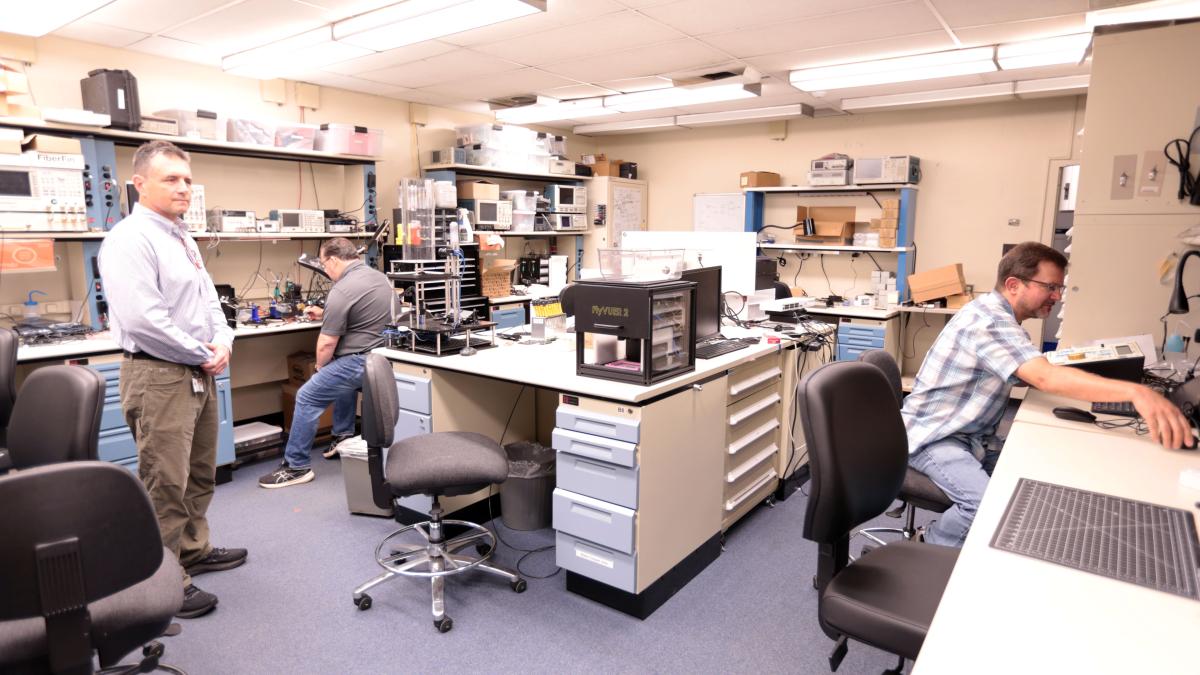
Back in the early 1990s, cancer researchers at NIH wanted to better understand how the levels of oxygen in a tumor affect its vulnerability to radiation therapy, but they had no way of precisely measuring oxygen in living, breathing tissue. That is, not until NIH’s IDEAS Lab got involved.
Working with the IRP cancer researchers, a team led by IDEAS Lab engineer Randy Pursley developed a way to use a technology called Electron Paramagnetic Resonance (EPR) imaging to create maps of oxygen levels in active clusters of cells, including tumors.
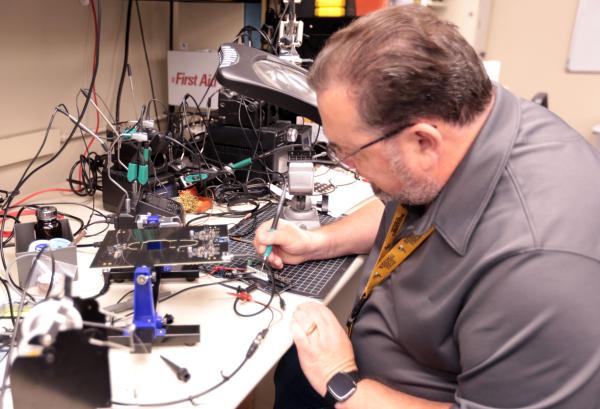
IDEAS Lab engineer Randy Pursley works on a circuit board for a machine his group is building.
“The signals in EPR last for microseconds, so the electronics needed to collect those signals are very challenging,” explains IRP senior investigator Murali Krishna Cherukuri, Ph.D., one of the cancer specialists involved in the project. “The developments we’ve made in my lab wouldn’t have been possible without Randy’s group.”
And those cancer specialists aren’t alone in benefiting from the Lab’s engineering expertise. Since its establishment under the leadership of IRP engineer Tom Pohida in 1995, the IDEAS Lab — short for Instrumentation Development and Engineering Application Solutions — has created hundreds of unique technologies and techniques to help scientists in a wide array of fields overcome obstacles they face in their research.
“If an NIH researcher is trying to perform an experiment and they need a piece of hardware or software they can’t go out and buy, we make it for them,” explains John Kakareka, who currently co-leads the Lab along with Pursley and Pohida. “Sometimes it’s modifying existing systems, sometimes it’s entirely novel things, and sometimes it’s duplicating something another research institution has done.”
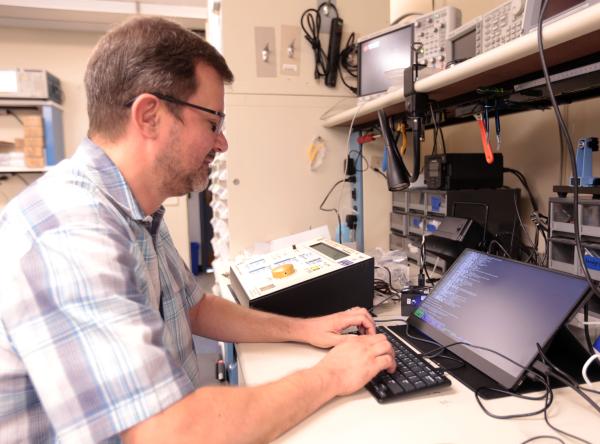
IDEAS Lab engineer John Kakareka debugs code for a machine one of his lab’s many collaborators wants to use to study pain.
For example, in the early 2010s, IDEAS engineers designed a portable device that detects traumatic brain injuries — a potential boon for soldiers deployed in remote locations and hospitals in countries that can’t afford the large, expensive equipment typically used to diagnose such injuries. Shortly afterwards, they created software that allows someone undergoing a brain scan in a magnetic resonance imaging (MRI) machine to move a computer-generated hand in virtual reality using a glove-like device. Researchers can then adjust how closely the virtual hand mimics the study participant’s movements in order to study the brain processes involved in the feeling of being in control of one’s body.
One of their most recent projects, led by IDEAS Lab electrical engineer Ghadi Salem, Ph.D., could turn out to be one of their most influential. A few years ago, Dr. Salem and his IDEAS colleagues created an AI-powered camera system that can continuously monitor mice during the day and at night via infrared imaging and automatically determine what the animals are doing at any given time — no small feat when the system has to provide high-quality footage and behavioral analysis yet be small enough to fit unobtrusively in decades-old animal cages not designed to accommodate such a system. What’s more, Ghadi is now leading the development of a similar system for monitoring and analyzing the behavior of the fruit flies many researchers use in their experiments.
“The mouse monitoring system seems like an easy-to-implement technology, but I think the fact that we were awarded a U.S. patent for it speaks to the fact that it’s critical and not easy,” Pohida says.
This video shows a short demonstration of the mouse monitoring system that IDEAS Lab electrical engineer Ghadi Salem, Ph.D., led the development of, as well as a similar system he is currently working on that monitors and analyzes the behavior of fruit flies. The different colors mark different parts of each animal's body, which helps the system's AI-powered algorithm determine what the animals are doing at any given time.
Unlike other IRP labs, the projects the IDEAS lab works on are always initiated by some other group of scientists at NIH. After those researchers explain their goals and the obstacles in the way, the IDEAS staff will work with them to figure out a solution. For each job, a project lead from the IDEAS Lab is selected to take charge of the Lab’s work on the project and guide it to completion. That means IDEAS engineers are constantly leapfrogging from one project to another.
“We don’t really worry about who’s the expert in one technology or another,” Kakareka says. “Some of us have more experience in certain things, but over time we could have three projects using one technology one year and then not touch it again for five years. I don’t like ever calling myself an expert in anything because we do so many things.”
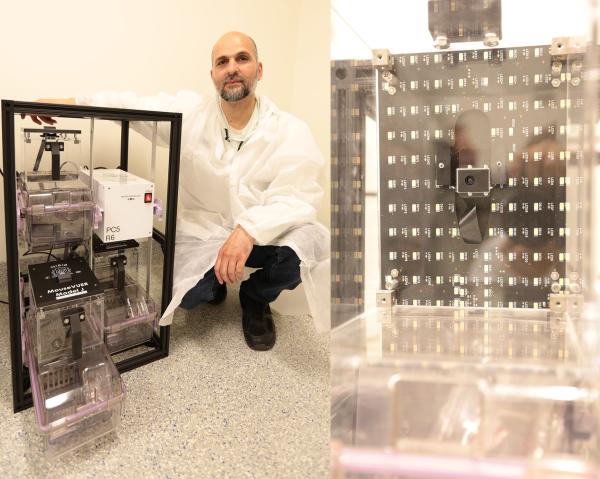
IDEAS Lab engineer Ghadi Salem, Ph.D., poses with the mouse monitoring system he helped develop (left). The system (right), which is positioned above the transparent roof of a mouse cage, includes a small camera and infrared LED lights that allow nighttime filming without disturbing the animals.
The IDEAS Lab is currently managing more than 100 projects in partnership with nearly 90 different research teams from all across the IRP. And ripples of the Lab’s work extend beyond just NIH. For instance, since the Lab figured out how to use EPR imaging to measure oxygen in tumors back in the 90s, researchers at several other academic institutions, including the University of Chicago and Dartmouth Medical School, have utilized the technique in their work. That has led to new insights into how best to treat cancer with radiation and immunotherapy.
More recently, a collaboration between the IDEAS Lab and physicians at both NIH and Children’s National Medical Center in Washington, D.C., led to an invention that has begun to permeate the world of cardiology. The technology, dubbed PRiME — for Physiological Recording in MRI Environment — enables cardiologists to monitor blood pressure and the heart’s electrical activity during MRI-guided catheterization procedures developed in the lab of IRP senior investigator Robert Lederman, M.D. These minimally invasive procedures, in which a thin, flexible fiber is threaded through the body into the heart to diagnose and treat various cardiac problems, had previously always required X-ray imaging and its accompanying exposure to radiation. This is a particularly thorny problem for children with chronic heart issues who might need to undergo such procedures repeatedly, since radiation from medical exams can slightly increase their risk of developing cancer later in life and they have most of their lives ahead of them to develop such an illness.
Now, thanks to the IDEAS team, Dr. Lederman, and their collaborators at Children’s National, cardiac catheterization can be safely done via radiation-free MRI imaging without giving up the ability to monitor the cardiovascular system, which had previously required monitoring equipment that is unable to function in an MRI’s strong magnetic field. The PRiME system has now been used to treat dozens of patients at Children’s National and the NIH Clinical Center, and after the IDEAS Lab distributed the design files publicly online, it was duplicated and deployed at several medical centers around the country.
“There are people who didn’t come to us directly, but could still use what we’re developing, so putting our stuff out there so they can continue their research is really valuable,” Kakareka says.
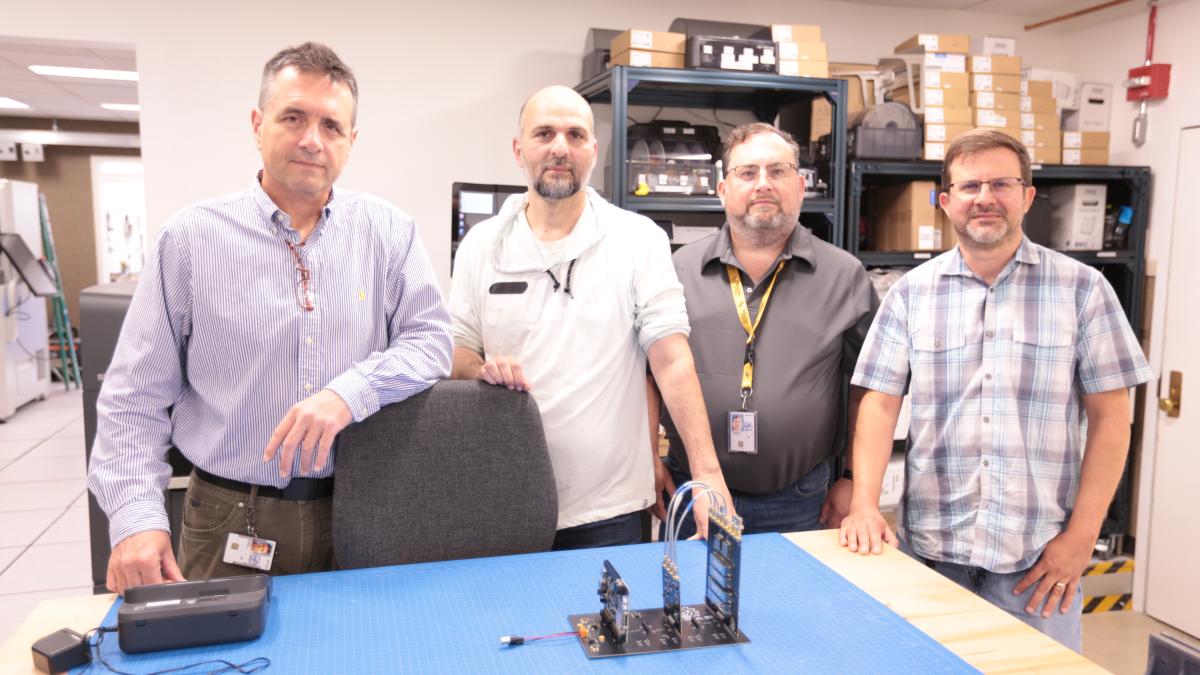
From left to right: Tom Pohida, Ghadi Salem, Randy Pursley, and John Kakareka
As the IDEAS Lab celebrates its 30th anniversary this year, its engineers continue to remove obstacles facing all sorts of IRP research projects. And while NIH’s large and eclectic population of scientists keeps IDEAS staff on their toes, Kakareka is confident they’re up to the challenge.
“We look to hire people who are open to doing different things,” Kakareka says. “If someone only wants to do electronic circuits, they’re not a good fit for our lab. We need people who can do different things and love learning new things. They value the variety and the constant change is exciting to them.”
Or, as IDEAS co-lead Pursley phrases it after working in the IDEAS Lab for its entire existence: “I’ve seen it all.”
The NIH IDEAS Lab, led by engineers Randy Pursley, John Kakareka and Tom Pohida, is part of NIH’s National Institute of Biomedical Imaging and Bioengineering (NIBIB).
This page was last updated on Monday, June 30, 2025